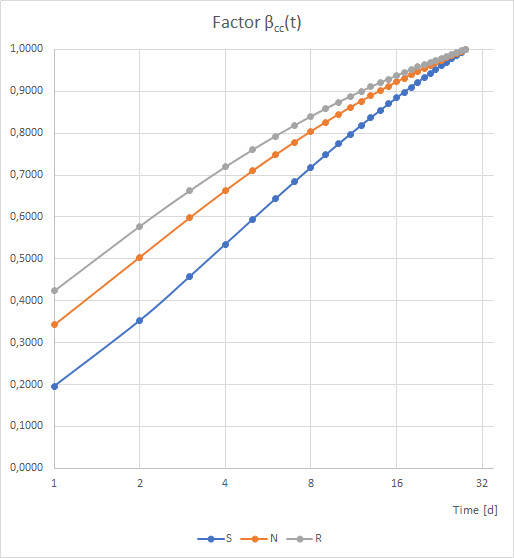Depending on Type of Effects Due to Restraint
To determine the effective tensile strength fct,eff, it is necessary to define if restraints should be considered sooner or later.
Early restraint is caused, for example, by the flow of hydration heat.
Late restraint is caused, for example, by temperature stress. It is a late restraint when the concrete has reached the strength required by the standard.
If only the early restraint is taken into account and there are no other specifications regarding the tensile strength, the effective early tensile strength can be assumed according to [1] as follows:
- After 3 days (simplified for thin structural components h ≤ 0.30 m) fct,eff ≈ 0.65 fctm
- After 5 days (simplified for medium structural components): fct,eff ≈ 0.75 fctm
- After 7 days (simplified for thick structural components h > 0.80 m): fct,eff ≈ 0.85 fctm
The specifications apply to common concrete with medium strength development (N).
Mean Tensile Strength in Relation to Time
With the formula EN 1992-1-1 3.1.2 (5) (3.4), you can assume the tensile strength depending on the concrete age. Using this formula, you can set up the following functions for strength development:
Slow- and Fast-Hardening Concrete
For concretes hardening slowly (L) or rapidly (R), the value of the tensile strength must be reduced or increased by 0.15 fctm.
Entering in Program
In RF-CONCRETE, you can factorize the effective tensile strength when entering it in the program:
For slow-hardening concrete, the tensile strength or the minimum reinforcement As,min can be reduced using a check box during the input to 0.85 As,min.
Notes
Determining the effective tensile strength has a significant influence on the result of the minimum reinforcement, because it directly reduces it. It is, therefore, worth considering if you consider only early restraint. The Eurocode gives no simplified assumption that the effective tensile strength can be reduced to 50%, as stated in DIN 1045-1.




